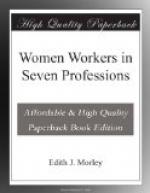In the meantime Miss Jex-Blake had applied to Edinburgh University for medical education, but had been refused on the score that it was impossible to make such alterations “in the interests of one lady.” Mrs Thorne, Miss Chaplin, Miss Pechey, and Mrs de Lacy Evans then decided to join Miss Jex-Blake, thus making five instead of one. They were allowed to matriculate, but forced to form separate classes and to guarantee 100 guineas for each class. They were not, however, allowed to receive scholarships, to which their work would have entitled them, on the score that they were women. Mrs Thorne states that their “success in the examination lists was their undoing,” as, owing to this, and to the fact that they were unjustly debarred from receiving the distinctions that they had gained, a great deal of bad feeling was aroused.
As the agitation increased, the efforts of these pioneers to obtain a qualifying course for women in Edinburgh, were supported by a committee of sympathisers, which speedily rose to five hundred members, and, after a severe struggle, the question of clinical teaching in the Infirmary was settled partially in the women’s favour in 1872. Later, the question of the validity of the original resolutions admitting women to the University was raised and decided against them. They had, therefore, been four years at the University and were finally excluded. This, however, proved to be only temporary as, in later years, the University reopened its medical degrees to women; but not in time to allow of the return of these courageous pioneers.
In the meantime Dr Garrett Anderson, having taken her degree in Paris, had been steadily working in London, forming the nucleus of the present New Hospital for Women, and the pioneers from Edinburgh came to London and helped her to start a school of medicine for women.
This was successfully accomplished owing to the kind help of many people, both within and without the profession, but no clinical teaching could be obtained, as all the big London hospitals were closed to women students. Finally, however, arrangements were made with the Royal Free Hospital in Gray’s Inn Road. It had no men’s medical school attached to it, and the admission of women to the hospital was due to the kind intervention of the Rt. Hon. J. Stansfeld, M.P., who met the Chairman of the hospital, Mr James Hopgood, while away on a holiday, and induced him to persuade the hospital authorities to give the dangerous experiment a trial. So seriously was it regarded, that the women students had to guarantee an indemnity to the hospital of 300 guineas annually in addition to their fees, as it was felt that the general support might decrease by, at least, this amount when the public became aware that there were medical women studying at the hospital! This was soon found not to be the case, and the yearly indemnity was generously remitted by the hospital authorities, the students simply paying the usual fees for instruction.




